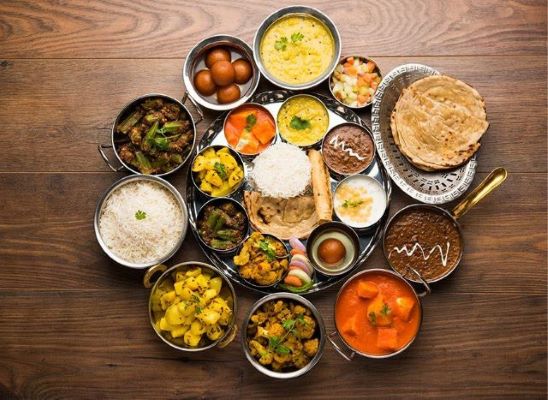The Taste of India cannot be captured in just one picture—it is an experience that unfolds through countless flavors, aromas, and traditions across the country. From the rich, creamy curries of the North to the spicy, coconut-infused delights of the South, from the sweet delicacies of the East to the bold and tangy street foods of the West, every region offers a unique culinary journey.
It’s a story of spices, centuries-old recipes, diverse cooking techniques, and cultural influences that make Indian cuisine one of the most vibrant and varied in the world. Whether it’s a royal Rajasthani thali, a simple yet flavorful Bengali fish curry, the irresistible street food of Mumbai, or the comforting home-cooked dal and roti, the true taste of India is found in every bite, every kitchen, and every celebration.
Taste of India: A Culinary Journey Through Flavors & Traditions
India is a land of diverse cultures, traditions, and flavors, offering one of the richest and most varied culinary experiences in the world. The Taste of India is not just about food—it’s about history, heritage, spices, and the stories that shape the cuisine of each region. From the royal kitchens of Rajasthan to the coastal delights of Kerala, every bite tells a tale of tradition, innovation, and authenticity.
1. The Spice Story: The Heart of Indian Cuisine
Indian food is incomplete without its bold and aromatic spices. Some of the most commonly used include:
- Turmeric – Known for its earthy flavor and healing properties.
- Cardamom – A fragrant spice used in both savory dishes and desserts.
- Cumin – Adds warmth and depth to curries and breads.
- Coriander – Fresh or ground, it provides a citrusy note.
- Garam Masala – A blend of various spices, unique to each household.
- Mustard Seeds – A staple in South Indian tempering.
- Asafoetida (Hing) – Adds umami and depth to vegetarian dishes.
Spices are not just for flavor; they have been used for centuries for their medicinal properties, forming the basis of Ayurvedic cooking.
2. Regional Flavors: A Diverse Gastronomic Landscape
North India: Rich & Royal
Known for its creamy curries, tandoori dishes, and rich breads, North Indian cuisine is influenced by Mughal and Persian cooking.
- Butter Chicken & Dal Makhani (Punjab) – A creamy, tomato-based delight.
- Rogan Josh & Kashmiri Pulao (Kashmir) – Rich, aromatic, and full of saffron.
- Rajasthani Thali (Rajasthan) – Includes Dal Baati Churma, Gatte ki Sabzi, and Ker Sangri.
- Parathas (Delhi) – Stuffed, crispy flatbreads, best enjoyed with pickles and yogurt.
South India: Spiced & Soulful
South Indian food is known for its rice-based dishes, coconut-infused curries, and fermented delicacies.
- Dosa, Idli & Uttapam (Tamil Nadu & Karnataka) – Served with chutneys and sambar.
- Hyderabadi Biryani (Telangana) – A royal, slow-cooked rice dish infused with spices.
- Kerala Sadya (Kerala) – A grand vegetarian feast served on a banana leaf.
- Chettinad Cuisine (Tamil Nadu) – Spicy, bold flavors with pepper and star anise.
East India: Sweet & Subtle
This region is famous for its fish-based dishes and an array of mouthwatering sweets.
- Rosogolla & Mishti Doi (Bengal) – Iconic, melt-in-the-mouth desserts.
- Pakhala Bhata (Odisha) – Fermented rice, a cooling summer delicacy.
- Sikkimese Thukpa & Momos (Sikkim) – Tibetan influences with a Himalayan twist.
- Shorshe Ilish (Bengal) – Hilsa fish cooked in mustard gravy.
West India: Fiery & Flavorful
From the street food of Mumbai to the royal delicacies of Gujarat and Goa’s Portuguese influence, the western states offer a mix of tastes.
- Pav Bhaji & Vada Pav (Maharashtra) – Mumbai’s famous street food.
- Dhokla & Thepla (Gujarat) – Light, fermented snacks packed with flavor.
- Goan Vindaloo & Bebinca (Goa) – A spicy pork dish and layered dessert with Portuguese roots.
- Pithla Bhakri (Maharashtra) – A rustic gram flour dish served with millet bread.
3. Indian Breads: More Than Just Roti
India’s bread culture is vast, with every region having its specialty:
- Naan & Tandoori Roti – Clay-oven baked perfection.
- Puri & Bhatura – Deep-fried and indulgent.
- Bajra Roti & Makki di Roti – Rural favorites made with millet or corn flour.
- Appam & Neer Dosa – Soft, lacy rice pancakes from South India.
4. Sweets & Desserts: The Grand Finale
Indian sweets are as diverse as its cuisine, offering everything from syrupy treats to milk-based confections.
- Gulab Jamun – Fried milk dumplings soaked in rose-scented syrup.
- Jalebi – Crisp, deep-fried spirals soaked in sugar syrup.
- Kaju Katli – A royal cashew fudge.
- Sandesh & Rasmalai – Bengali delicacies made with fresh paneer and flavored with saffron.
- Petha & Ghewar – Specialties from Agra and Rajasthan.
5. Beverages: From Chai to Lassi
Indian drinks are just as varied as its food:
- Masala Chai – The iconic spiced tea enjoyed across the country.
- Filter Coffee – South India's rich and aromatic brew.
- Lassi – A yogurt-based drink, sweet or salty, popular in Punjab.
- Thandai – A cooling, nutty drink often consumed during festivals.
- Aam Panna – A tangy raw mango drink, perfect for summer.
6. Street Food: The Soul of Indian Cuisine
From chaat to kebabs, India’s street food is a must-try. Some of the top picks include:
- Pani Puri (Gol Gappa) – Crisp shells filled with spicy, tangy water.
- Dahi Puri – A yogurt-based variation of Pani Puri.
- Kathi Rolls (Kolkata) – Parathas wrapped around spicy fillings.
- Sev Puri & Bhel Puri (Mumbai) – Crunchy, sweet, spicy, and tangy.
7. Eating Etiquette & Traditions
Indian dining is deeply rooted in culture:
- Eating with Hands – Enhances the sensory experience and connects you with the food.
- Thali Culture – A complete meal with small portions of various dishes.
- Festive Feasts – Each festival brings a special dish, such as modaks for Ganesh Chaturthi or gujiyas for Holi.

